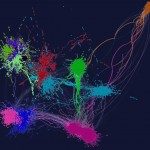Link to Pubmed [PMID] – 38020967
Link to DOI – 10.1016/j.xgen.2023.100439
Cell Genom 2023 Nov; 3(11): 100439
We designed and synthesized synI, which is ∼21.6% shorter than native chrI, the smallest chromosome in Saccharomyces cerevisiae. SynI was designed for attachment to another synthetic chromosome due to concerns surrounding potential instability and karyotype imbalance and is now attached to synIII, yielding the first synthetic yeast fusion chromosome. Additional fusion chromosomes were constructed to study nuclear function. ChrIII-I and chrIX-III-I fusion chromosomes have twisted structures, which depend on silencing protein Sir3. As a smaller chromosome, chrI also faces special challenges in assuring meiotic crossovers required for efficient homolog disjunction. Centromere deletions into fusion chromosomes revealed opposing effects of core centromeres and pericentromeres in modulating deposition of the crossover-promoting protein Red1. These effects extend over 100 kb and promote disproportionate Red1 enrichment, and thus crossover potential, on small chromosomes like chrI. These findings reveal the power of synthetic genomics to uncover new biology and deconvolute complex biological systems.

